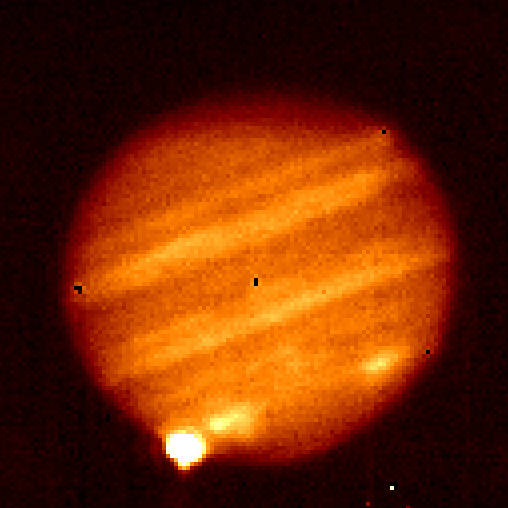MIRAC2 10.3 micron image of Jupiter during the impact of the comet,
Shoemaker-Levy-9, R fragment.

MIRAC2 10.3 micron image of Jupiter during the impact of the comet,
Shoemaker-Levy 9, R fragment.
This is a single 2 second exposure taken at the NASA IRTF July 21,
1994, 5:44:48 UT as part of the IRTF Comet Collision Campaign. It
is displayed as a raw image with no pixel masking or flat fielding.
The only processing is the subtraction of an off-source sky image
taken by beam switching with the telescope. The pixel size is .4
arcsec (1560 km at a distance of 5.21 AU). The equitorial angular
diameter of Jupiter is approximately 38 arcsec.
The radiation from Jupiter at this wavelength comes from ammonia gas
in the stratosphere at a level of approximately 300 mbar with a
brightness temperature of 130 K. The temperature sensitivity in
this image is .15 K/arcsec rms.
The R impact plume, shown near
maximum brightness, has a 7.85 to 10.3 um color temperature of
approximately 1500 K. For this display, the plume has been clipped
at 7% peak intensity in order to show the features of the Jupiter
disk. The prominent large bright areas to the right at the same
Jupiter latitude are at the L and K impact sites. They are still a
few degrees above their surroundings 1 1/2 days after the impacts.
rms.
The R impact plume, shown near
maximum brightness, has a 7.85 to 10.3 um color temperature of
approximately 1500 K. For this display, the plume has been clipped
at 7% peak intensity in order to show the features of the Jupiter
disk. The prominent large bright areas to the right at the same
Jupiter latitude are at the L and K impact sites. They are still a
few degrees above their surroundings 1 1/2 days after the impacts.
MIRAC2 was built and is operated by the University of Arizona and
the Smithsonian Astrophysical Observatory. It received support from
the University of Arizona, Smithsonian Astrophysical Observatory,
National Science Foundation, and National Aeronautics and Space
Administration. It is operated and maintained by William F. Hoffmann
(U/A), Giovanni G. Fazio (SAO), Joseph L. Hora (U. Hawaii),
Lynne K. Deutsch (Boston Univ.), and
Aditya Dayal (U/A). The camera
utilizes a Rockwell HF-16 128 x 128 hybrid Si:As BIB array.
Back to MIRAC Home Page
 rms.
The R impact plume, shown near
maximum brightness, has a 7.85 to 10.3 um color temperature of
approximately 1500 K. For this display, the plume has been clipped
at 7% peak intensity in order to show the features of the Jupiter
disk. The prominent large bright areas to the right at the same
Jupiter latitude are at the L and K impact sites. They are still a
few degrees above their surroundings 1 1/2 days after the impacts.
rms.
The R impact plume, shown near
maximum brightness, has a 7.85 to 10.3 um color temperature of
approximately 1500 K. For this display, the plume has been clipped
at 7% peak intensity in order to show the features of the Jupiter
disk. The prominent large bright areas to the right at the same
Jupiter latitude are at the L and K impact sites. They are still a
few degrees above their surroundings 1 1/2 days after the impacts.